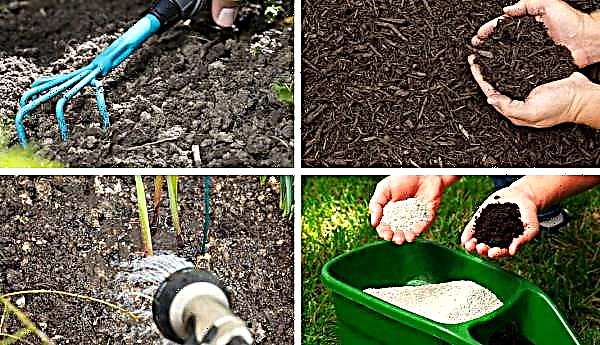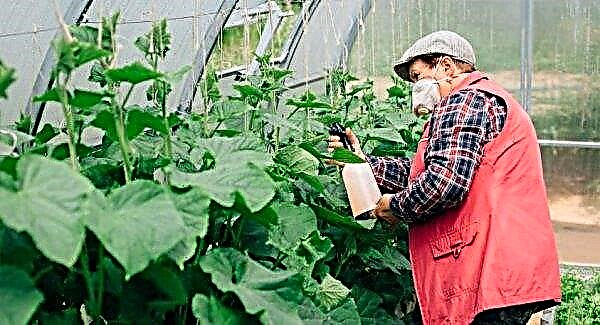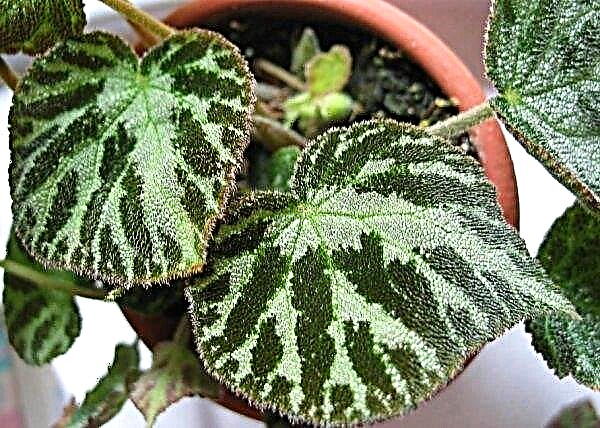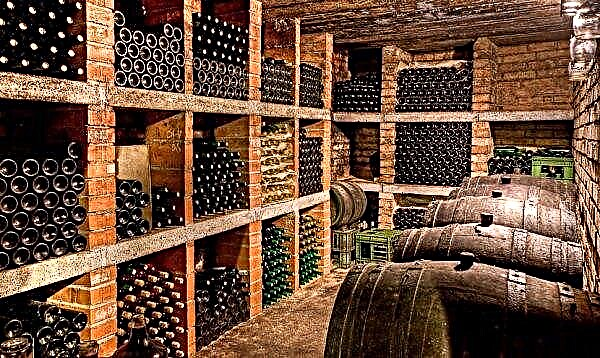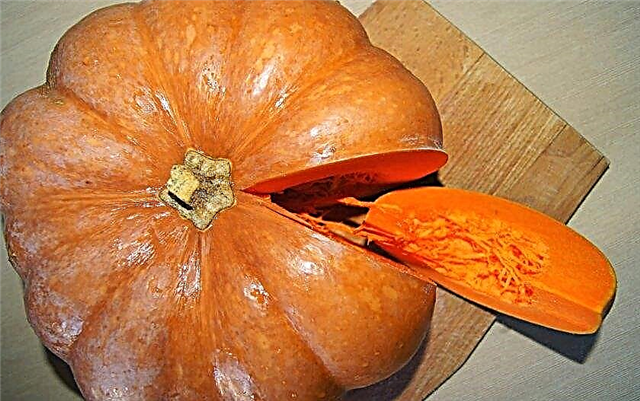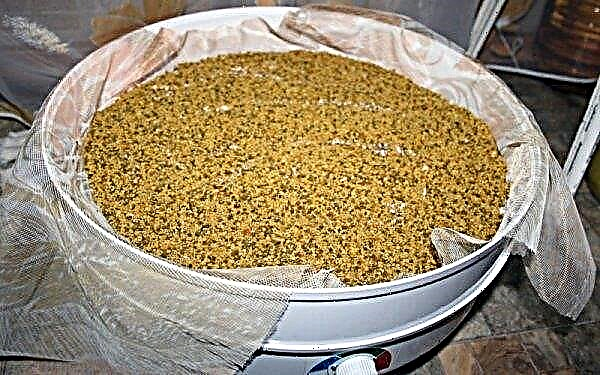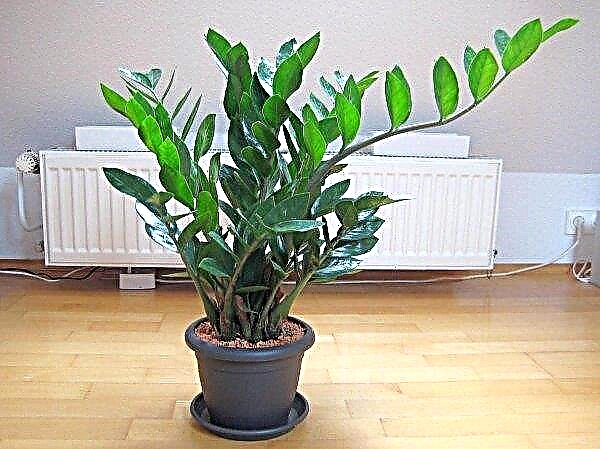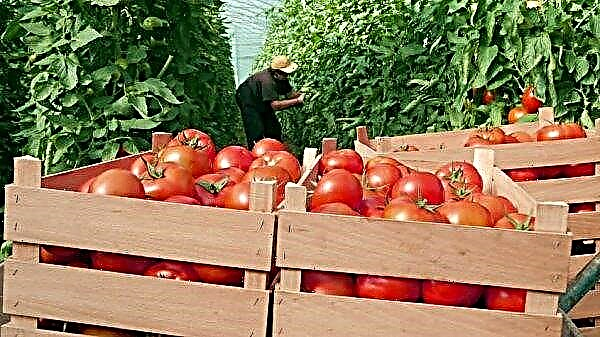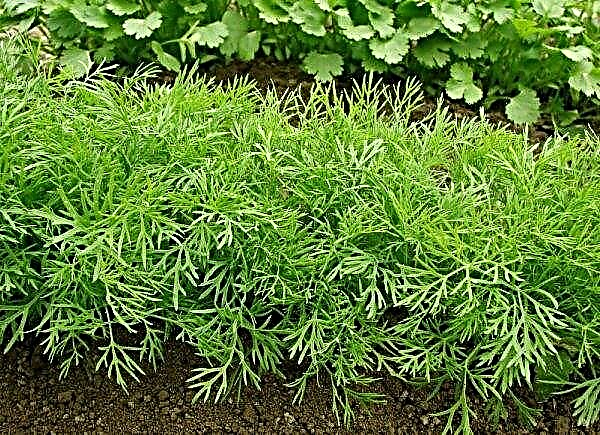The main danger of all cultivated plants are considered all kinds of pests that develop on shoots and foliage. Their presence always leads to the wilting of the green mass and quite often provokes their death. However, not every gardener can prevent a problem in time and confidently repulse it. The article will examine in detail what is the main reason for the defeat of gooseberry foliage, and also describes the main ways of controlling pests.
Pest Varieties
A lot of insects can develop on the gooseberry, its branched stems become the best habitat for the production and production of offspring of many species. However, such a neighborhood does not always have to be alarming, since often the bush becomes an object of protection for small creatures. That is why the following species, which are extremely dangerous for culture, are able to instantly eat up foliage and hit its shoots.
Did you know? Gooseberries are considered a traditional species of vegetation in Europe and Africa, however, its first description was given only in 1536 by a French scientist and doctor Jean Ruel.
Gooseberry fire
The adult of this pest is a grayish-white butterfly of a small size, with a wingspan of up to 3 mm. The wings are often covered with brown stripes and scales, which is their characteristic feature.
In the spring, this pest lays eggs inside the flowers, due to which the young larva almost completely eats berries from the inside. As it develops, a small larva grows to a green caterpillar, with a black head.

In the course of life, it affects the flesh of berries, which then redden and rot prematurely. In this case, the fruits are covered with a characteristic cobweb, thanks to which it is best to recognize the appearance of a pest.
About a month after birth, the caterpillars of the fire-tongue descend to the basal layer of soil, take the form of a pupa and winter in the upper layers of the soil. This insect is characteristic of many fruit crops, characterized by juicy berries, including those found on currants.
Video: Protecting gooseberries from gooseberry moth caterpillars
Yellow sawfly
A typical sawfly is a red-black or yellow-black insect, up to 7 mm long. This creature appears in large numbers around the second half of May, after young foliage appears on the gooseberry and other fruit shrubs. At this time, sawfly mass reproduction occurs, after which the insect lays eggs along leaf veins.
A few weeks after laying from the eggs, small caterpillars of a bluish-green color appear with a dark head. On top of the main color, insects can see black dots located over the entire surface of the body.

The longevity of the caterpillars is about a month, after which they burrow into the basal layer of soil. At a depth of 5–7 cm, insects form pupae, after which their development continues in the next season.
Moth
The most common pest of the gooseberry bush and currant can be called the moth. This is a fairly large butterfly, with a wingspan of 40-50 mm. The wings of the insect are covered with a bright ornament of a variety of black dots, as well as yellow and brown stripes. At the same time, the head of the butterfly has a dark shade, and the abdomen is distinguished by an ornament of yellow-black spots.
For the first time, plant growers meet moths in early spring. Pest larvae emerge from the root layer of the soil and massively populate the surface of the gooseberry. These are large caterpillars up to 40 mm long. The back of them has a gray-white hue, and the abdomen is yellow in color, with all kinds of black transverse stripes. At the onset of a favorable period, the larvae pupate on the green mass or shoots, after which butterflies appear in about a month.
Around the end of July, the butterflies again visit the gooseberries and lay eggs on the back of the leaves, from which the larvae reappear. They hibernate in pupae, in the root layer of the soil of the bush, and at least 1 month passes after leaving the egg before the first pupation. Thanks to this development cycle, the bushes are affected by the pest at the beginning and end of the vegetative season, which almost always provokes dire consequences for the crop.
Aphid
Almost every gardener met with aphids; this pest is widespread in the temperate climate zone and is the main parasite of most fruit crops. The average individual is a small insect about 2 mm long. It has an ellipsoidal, soft body, green or light green in color.
Important! Aphids are prone to instant breeding, one female per season is able to give several generations of offspring at once. That is why the fight against the pest should begin immediately.
As breeding aphids form eggs, before wintering they are small dense formations of black color. Their pests are laid in the area of young kidneys. In spring, young individuals emerge from the eggs, which feed on the juice of the kidneys. Often this leads to the death of plants at the beginning of the growing season, especially if the plant has low immunity.

Kidney leaflet
Leafworms belong to a small group of butterflies from the order Lepidoptera. These creatures are of medium size, the wingspan of the average representative is 20-30 mm. The main color of an adult insect is of various gray shades, on top of which an ornament of alternating spots and stripes of various shapes and sizes appears.
The life cycle of a pest begins with a small caterpillar of a pale green color. Insects appear on the bush in early spring, after the average daily temperature reaches about + 10 ° С. A parasitic pest forms a chrysalis, from which a butterfly grows.
For 2 months, she lays eggs on the back of the leaf, which allows you to form up to 2 generations of young individuals. After the onset of cold weather, the caterpillars concentrate near the kidneys and form a cocoon in which they hibernate until the next year.

Consequences of the appearance
The main purpose of the reproduction of insect pests on the surface of the bush is to provide themselves and their offspring with the necessary food supply for growth and development, therefore, with mass development, they often lead to the complete or partial destruction of the green mass of plants.
We recommend that you familiarize yourself

As a result of this, the plant fails to fully support vital activity and metabolism.
In addition, foliage creates a special microclimate for the shoots, protecting them from intense sunlight.
In the case of complete loss of leaves, this can lead to the death of a valuable fruit crop from lack of nutrition or drying out of shoots.
If the parasite was not able to completely destroy the leaves, such a plant will remain viable, however, its productivity and development activity will be inhibited. In addition, immunity will also be subject to oppression of gooseberries, and this in some cases, in addition to parasitic invasion, can cause an infectious disease caused by all kinds of viruses, bacteria or fungi.

Which caterpillars eat gooseberry leaves
The most dangerous for the gooseberry leaf and other fruit shrubs are considered the following insects:
- Aphid - as it develops, the insect eats the juice of the leaves, which gradually causes them to curl. This leads to the formation of lumps of green plant mass, in which aphids massively multiply. With untimely elimination of the pest, the insect leads to a slow withering of the bush.
- Yellow sawfly - after hatching, the parasites feed heavily on the green mass of gooseberries, in just a couple of days this leads to the complete disappearance of the leaf on the bush.
- Moth - caterpillars parasitize twice a season: the first time they are able to completely eat all the green mass of plants in early spring, and then in August. Thus, bushes can grow with leaf pathologies throughout the vegetative period.
- Leaflet - this parasite feeds on juice and green mass of bushes, entwining them with a web-like coating. Such a lesion is observed twice a season: in spring and during the ripening period of berries. This causes not only oppression of gooseberries and twisting of green mass, but also a deterioration in the quality of its fruits.

In addition, bushes can be affected by less dangerous pests, which are not capable of causing mass death of leaves, but adversely affect the fruiting and development of gooseberries. These include the spider mite, gall midge, leaf gnaw, glass-case and goldfish.
Methods of struggle, rules of application
After the first signs of the appearance of a pest in the area, an effective fight against parasitic insects should immediately be launched. For this, there are a lot of various means, as well as techniques that are not inferior in effectiveness to one another. Moreover, they are usually divided into traditional (based on chemical solutions) and folk (prepared from improvised means).
Chemicals
Over the years, chemical protective agents have been actively used in agronomy. They give instant results and are able to destroy parasites even in case of mass development. However, a certain group of substances can be called safe for the crop, as well as for the environment.
Inta-Vir
This tool refers to contact chemicals that affect the intestinal and nervous systems of insects. Due to this, within a few hours after application, the caterpillars lose their ability to eat food and die one day after processing.
 "Inta-Vir" is widely used for all kinds of gooseberry pests and has lethal effect for 52 types of parasites, but best of all it helps to cope with aphids and glass.
"Inta-Vir" is widely used for all kinds of gooseberry pests and has lethal effect for 52 types of parasites, but best of all it helps to cope with aphids and glass.
The working solution is prepared from 1 tablet of the product and 10 l of water. The resulting liquid is treated with shoots and leaves of the bush with a calculation of 2 l / bush. Spray plants need twice. The first time this is done before flowering begins, the second treatment is performed within a week after harvesting.
Decis
The drug "Decis" enters the body of pests through the intestinal tract. A few hours after the defeat, it provokes a blockade of the nervous system, which leads to disruption of the activity of the whole organism as a whole. In the final result, this causes the gradual death of insects.

The effectiveness of the drug against all kinds of pests is extremely high and is approximately 8 points out of 10 possible. A solution for spraying is prepared from 1 g of concentrate and 10 l of water. Depending on the size of the bush, the flow rate of the working fluid is 10 l / 2–5 plants. The plantations should be treated twice, with an interval of 14–20 days, but no later than 30 days before the collection of berries.
Important! In some cases, Decis can cause burns to young shoots, so they are sprayed with it 1–2 year old seedlings with extreme care.
Kinmix
The main purpose of using Kinmix is to overcome the development of small sucking parasites on fruit and ornamental crops in the area. It acts on insects by the intestinal contact method, causing them paralysis of the nervous system with subsequent death. The product is used for a wide range of parasites, but best of all it protects against aphids and sawflies.

To prepare a mixture for spraying, one ampoule of the concentrate should be dissolved in a liter of water. The resulting liquid must be brought to 10 l, and then used for processing leaves and shoots with a flow rate of 1-1.5 l / bush. You can process plants throughout the growing season, but no more than 2 times, with an interval of 14 days. At the same time, from the last spraying to picking berries, at least 3 weeks should pass.
Iskra-M
Iskra-M is used for a wide range of sucking and gnawing parasites of fruit and ornamental crops. The powerful contact effect of the drug for a long time helps to destroy the majority of existing gooseberry pests, which will provide the plantations with excellent immunity for the whole season.

Prepare a treatment agent at the rate of 1 ml of concentrate / 1 l of water. The resulting mixture is thoroughly sprayed over the entire surface of the bush with a flow rate of 1-1.5 l / bush. Such treatments are carried out throughout the growing season, twice, with an interval of 20 days, but no less than 20-30 days before the collection of berries.
Fitoverm
This insecticide is designed to control any pests of fruit and ornamental plants, including indoor species. Is a drug derived from the vital products of fungi of the genus Streptomyces and acts on parasitic species by the intestinal contact method, causing a nerve-paralytic effect.
A preparation is prepared at the rate of 1 ml / 1 liter of water, the bushes are sprayed with the liquid at a flow rate of 100 ml / 1 m² of plantings. Such procedures are done at least 2 times, until the complete destruction of insects and their larvae, with an interval of 14–20 days.

"Fufanon"
"Fufanon" is a complex insecticide that has a damaging effect on most types of gnawing and sucking parasites of fruit and ornamental crops. The drug enters the body in a contact way, causing all kinds of neuro-paralytic lesions of the body and the death of parasites.
To prepare a mixture for spraying plants, you need to dissolve 10 ml of the concentrate in 500 ml of water, and then bring the resulting liquid to 10 liters. The working solution is used at the rate of 1–1.5 l / bush, while the multiplicity of treatments should be no more than 2 procedures. The last of them is carried out no later than 20-30 days before picking berries.

Folk remedies
In addition to highly active chemicals, pest control can also be done using folk remedies. They are less dangerous for plants and future crops, and are also not able to accumulate in berries. In addition, their use contributes to the transformation of simple truck farming into organic farming.
Did you know? Mankind has been using insecticides for many centuries. Even in Ancient Greece, sulfur fumigation was used as the best panacea not only for pests, but also for all kinds of infections of fruit species.
Ash
Such a preparation is prepared from 10 liters of pure water and 300 g of sifted wood ash. The mixture needs to be insisted for about 2 days, after which it is carefully filtered. Before use, add 40-50 g of liquid soap to the liquid and shake well.

Use this infusion to spray the bushes throughout the growing season, with an interval of 7-14 days. In this case, the treatment should be carried out at least 2-3 times, no later than 2 weeks before harvesting.
Tobacco dust
This tool is prepared on the basis of half a glass of tobacco dust, grated laundry soap and 3 liters of water. All ingredients are thoroughly mixed and insisted for about 3 days. The resulting liquid must be filtered, and then twice, with an interval of 14 days, spray the plantings. Such procedures are carried out throughout the growing season.
Vinegar
Simple table vinegar is considered the most cost-effective means of combating gooseberry parasites. For its preparation, it is enough to dissolve 3 tbsp in 10 l of water. l 9% vinegar. The bushes are abundantly sprayed with the product at least 2-3 times, with an interval of 7-14 days.They do such procedures throughout the entire growing season, but no later than 10–20 days before the berries are picked.

Mustard
The pungent smell and burning properties of mustard do not tolerate many insects, including gooseberry pests. To prepare such a tool is quite simple: you need to dissolve 100 g of powder in 10 liters of water. The mixture is insisted for about a day, after which 40 g of grated laundry soap is added to it before use. The resulting fluid is generously sprayed with bushes in several runs, with an interval of 7-14 days. If gooseberries have undergone massive damage, the concentration of the substance is increased to 200 g / 10 l of water.
Ammonia
Liquid ammonia also has excellent insecticidal properties. To prepare a solution, 50 ml of liquid must be dissolved in 10 l of water, and then add to the mixture about 50 g of grated laundry soap.
The bushes are abundantly sprayed with the agent throughout the season, such procedures are done in complexes of 2 visits, with a break between each of at least 14 days. The last procedure should be carried out no later than 20 days before harvesting.
 After treatment with all kinds of plant protection products, it is not recommended to water for 2 to 3 days, otherwise the procedure will not give the necessary results.
After treatment with all kinds of plant protection products, it is not recommended to water for 2 to 3 days, otherwise the procedure will not give the necessary results.
Prevention, Seasonal Features
As practice shows, timely prevention is always the best pest control measure on the site. It allows you to avoid mass infections, as well as prevent a decrease in the yield of fruit species.
- To do this, follow just a few simple rules:
- it is necessary to carry out preventive spraying of bushes in the early spring, before flowering and in late autumn;
- at the beginning of the growing season, pour boiling water on the gooseberry tree trunk circle (avoiding contact with the plant itself);
- periodically weave the trunk circle;
- provide bushes with the necessary microclimate and an intensive feeding system;
- at the end of the season, remove foliage and burn all plant debris.
Gooseberry pests are not uncommon, plants are the best habitat for all kinds of insects and their larvae. Today, many such parasites are known, but most often the culture is affected by aphids, sawflies, moths and leafworms, so every lover of fragrant berries in their area must create a comprehensive insect protection system, otherwise the bush will die within a short time.

